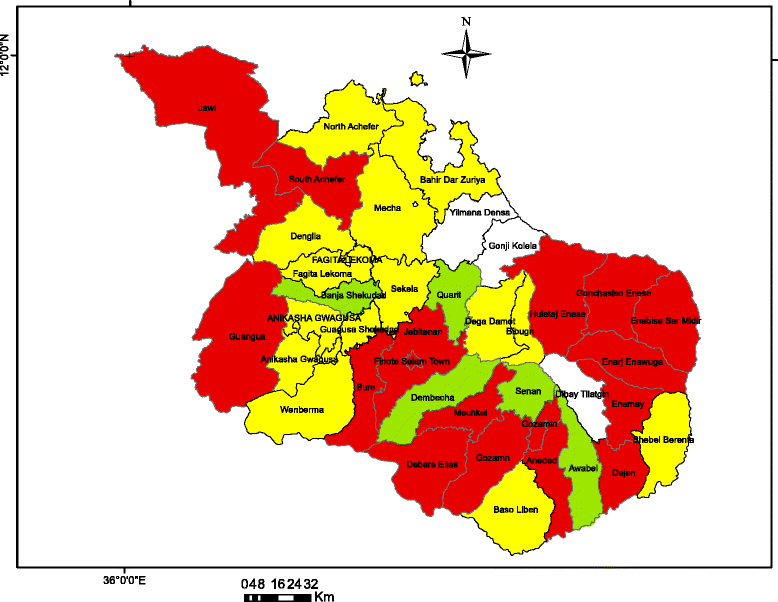Childhood diarrhea in high and low hotspot districts of Amhara Region, northwest Ethiopia: a multilevel modeling
- PMID: 27184552
- PMCID: PMC5025988
- DOI: 10.1186/s41043-016-0052-2
Childhood diarrhea in high and low hotspot districts of Amhara Region, northwest Ethiopia: a multilevel modeling
Abstract
Background: Childhood diarrhea is one of the major public health problems in Ethiopia. Multiple factors at different levels contribute to the occurrence of childhood diarrhea. The objective of the study was to identify the factors affecting childhood diarrhea at individual and community level.
Methods: A cross-sectional study design was employed from February to March 2015 in high and low hotspot districts of Awi and West and East Gojjam zones in Amhara Region, northwest Ethiopia. Districts with high and low hotspots with childhood diarrhea were identified using SaTScan spatial statistical analysis. A total of 2495 households from ten (five high and five low hotspot) randomly selected districts were included in the study. A semi-structured questionnaire was used to collect data. Data were entered and cleaned in Epi Info 3.5.2 version and analyzed using Stata version 12. A multilevel logistic regression was used to identify factors associated with childhood diarrhea.
Results: The prevalence of childhood diarrhea was 13.5 % and did not show significant variation between high [14.3 % (95 % CI 12.3-16.2 %)] and low [12.7 % (95 % CI 10.9-14.6 %)] hotspot districts. Individual- and community-level factors accounted for 35 % of childhood diarrhea variation across the communities in the full model. Age of children (6-35 months), complementary feeding initiation below 6 months, inadequate hand washing practices, limited knowledge of mothers on diarrhea, lowest wealth status of households, and longer time interval to visit households by health extension workers were factors for increasing the odds of childhood diarrhea at the individual level. At the community level, lack of improved water supply and sanitation and unvaccinated children with measles and rotavirus vaccine were the factors associated with childhood diarrhea.
Conclusions: In this study, childhood diarrhea occurrences remained high. Both individual- and community-level factors determined the occurrence of diarrhea. Interventions should consider both individual- and community-level factors to reduce the occurrence of childhood diarrhea.
Keywords: Childhood diarrhea; Children; Ethiopia; Multilevel analysis; Sanitation; Water.
Figures
Similar articles
-
Individual and community-level risk factors in under-five children diarrhea among agro-ecological zones in southwestern Ethiopia.Int J Hyg Environ Health. 2020 Mar;224:113447. doi: 10.1016/j.ijheh.2019.113447. Epub 2020 Jan 3. Int J Hyg Environ Health. 2020. PMID: 31978740
-
Association between microbial water quality, sanitation and hygiene practices and childhood diarrhea in Kersa and Omo Nada districts of Jimma Zone, Ethiopia.PLoS One. 2020 Feb 19;15(2):e0229303. doi: 10.1371/journal.pone.0229303. eCollection 2020. PLoS One. 2020. PMID: 32074128 Free PMC article.
-
Water supply, sanitation and hygiene interventions and childhood diarrhea in Kersa and Omo Nada districts of Jimma Zone, Ethiopia: a comparative cross-sectional study.J Health Popul Nutr. 2019 Dec 13;38(1):45. doi: 10.1186/s41043-019-0205-1. J Health Popul Nutr. 2019. PMID: 31836024 Free PMC article.
-
Prevalence and risk factors of diarrhea among under-five children in Ethiopia: A systematic review and meta-analysis.BMC Public Health. 2025 May 16;25(1):1815. doi: 10.1186/s12889-025-22939-2. BMC Public Health. 2025. PMID: 40380143 Free PMC article.
-
Prevalence and determinants of diarrhea among under-five children in Ethiopia: A systematic review and meta-analysis.PLoS One. 2018 Jun 28;13(6):e0199684. doi: 10.1371/journal.pone.0199684. eCollection 2018. PLoS One. 2018. PMID: 29953555 Free PMC article.
Cited by
-
Correlates of childhood morbidity in Nigeria: Evidence from ordinal analysis of cross-sectional data.PLoS One. 2020 May 14;15(5):e0233259. doi: 10.1371/journal.pone.0233259. eCollection 2020. PLoS One. 2020. PMID: 32407377 Free PMC article.
-
The Role of Household Flooring on Childhood Diarrhea Among Children 0 to 23 Months of Age in Ethiopia: A Nationally Representative Cross-Sectional Study Using a Multi-Level Mixed Effect Analysis.Environ Health Insights. 2021 Dec 12;15:11786302211064423. doi: 10.1177/11786302211064423. eCollection 2021. Environ Health Insights. 2021. PMID: 34924758 Free PMC article.
-
To do's after war: Priorities for acute diarrheal diseases intervention among under-five children in conflict settings of Raya Kobo district, Northeastern Ethiopia.Heliyon. 2024 Mar 20;10(7):e28394. doi: 10.1016/j.heliyon.2024.e28394. eCollection 2024 Apr 15. Heliyon. 2024. PMID: 38633653 Free PMC article.
-
Characteristics of Pathogenic Escherichia coli Associated with Diarrhea in Children under Five Years in Northwestern Ethiopia.Trop Med Infect Dis. 2024 Mar 21;9(3):65. doi: 10.3390/tropicalmed9030065. Trop Med Infect Dis. 2024. PMID: 38535888 Free PMC article.
-
Understanding the context of healthcare utilisation for children under-five with diarrhoea in the DRC: based on Andersen behavioural model.BMC Health Serv Res. 2022 Feb 4;22(1):144. doi: 10.1186/s12913-022-07530-4. BMC Health Serv Res. 2022. PMID: 35120503 Free PMC article.
References
-
- WHO. Diarrheal Diseases. World Health Organization 2013.
-
- Lozano R, Naghavi M, Foreman K, Lim S, Shibuya K, Aboyans V, et al. Global and regional mortality from 235 causes of death for 20 age groups in 1990 and 2010: a systematic analysis for the Global Burden of Disease Study 2010. Lancet. 2012;380(9859):2095–128. doi: 10.1016/S0140-6736(12)61728-0. - DOI - PMC - PubMed
-
- Tate JE, Burton AH, Boschi-Pinto C, Steele AD, Duque J, Parashar UD. 2008 estimate of worldwide rotavirus-associated mortality in children younger than 5 years before the introduction of universal rotavirus vaccination programmes: a systematic review and meta-analysis. Lancet Infect Dis. 2012;12(2):136–41. doi: 10.1016/S1473-3099(11)70253-5. - DOI - PubMed
Publication types
MeSH terms
LinkOut - more resources
Full Text Sources
Other Literature Sources
Medical


